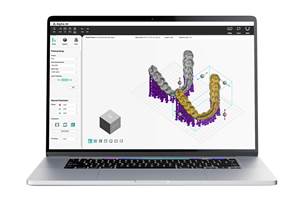NTU and HP Announce Corporate Innovation Lab in Asia
HP’s first university laboratory collaboration in Asia will focus on digital manufacturing technologies, from 3D printing to machine learning and more.
Nanyang Technological University, Singapore (NTU Singapore), HP Inc., and the National Research Foundation (NRF) are collaborating on a new $84 million HP-NTU Digital Manufacturing Corporate Lab.
As Singapore’s newest corporate research laboratory and HP’s largest university research collaboration worldwide, the HP-NTU Corporate Lab will drive innovation, technology, skills and economic development critical for the advancement of the Fourth Industrial Revolution. This is HP’s first university laboratory collaboration in Asia.
The lab supports Singapore’s push toward industry transformation in the areas of digital manufacturing and 3D printing technologies. “Advanced Manufacturing and Engineering” is one of four technology domains under the Research, Innovation and Enterprise (RIE) 2020 Plan, which is Singapore’s national strategy to develop a knowledge-based innovation-driven economy and society.
Located at NTU, the HP-NTU Digital Manufacturing Corporate Lab was launched by Heng Swee Keat, minister for finance and chairman of the NRF. The NRF facilitates the creation of corporate labs via public-private partnerships. The Corporate Lab is the 13th supported by NRF and the seventh such lab at NTU.
The lab’s 100 researchers and staff will focus on digital manufacturing technologies, specifically in areas of advancing 3D printing, artificial intelligence, machine learning, new materials and applications, cybersecurity and customization.
The partnership agreement was signed by NTU Vice President (Research) Prof Lam Khin Yong and HP Chief Technology Officer and Head of HP Labs Shane Wall. It was witnessed by Guest-of-Honor Minister of Finance and NRF Chairman Heng Swee Keat, NTU President Professor Subra Suresh, and HP Inc. Chief Executive Officer Dion Weisler.
"Corporate laboratories are an integral part of our strategy to anchor joint R&D partnerships between our universities and companies in areas that have direct relevance to the growth of industries in Singapore,” says Low Teck Seng, NRF professor. “The HP-NTU Digital Manufacturing Corporate Laboratory is significant to our long-term competitiveness in the advanced manufacturing sector, and ensures that we stay relevant in the Fourth Industrial Revolution that is evolving and growing rapidly world-wide. It will also strengthen our capabilities to support multinational companies for expansion from Singapore into the region.”
NTU President Prof Subra Suresh says the partnership with HP is a significant milestone for NTU, as 3D printing along with adjacent technologies such as artificial intelligence (AI), machine learning and cybersecurity are integral parts of the Fourth Industrial Revolution.
“NTU has established deep capabilities and is a recognized leader in the areas of machine learning, data science and additive manufacturing,” Suresh says. ”These cutting-edge technologies are now an integral part of NTU’s education and research ecosystem, and the NTU Smart Campus serves as a test bed for them, aligned with Singapore’s vision of transforming into a Smart Nation.”
“Together with HP Inc., a renowned innovator and leader in the tech industry, NTU seeks to address today’s fundamental challenges with solutions that will benefit both industry and society in Singapore and the world, such as developing automation that is capable of boosting manufacturing productivity,” he continues.
“The World Economic Forum estimates more than $100 trillion in value will be created by digital transformation across all industries in the next 10 years,” says Dion Weisler, CEO and president, HP Inc. “HP is helping lead the development of the underlying technologies, like 3D printing, that will enable the benefits of this transformation. Singapore is one of our key worldwide technology development and manufacturing centers in Print technology. The HP-NTU Digital Manufacturing Corporate Lab will significantly deepen our involvement here and serve as a nucleus for this ecosystem. We are proud to collaborate with NTU and we are looking forward to this becoming a blueprint for innovation, collaboration and economic progress.”
Related Content
NCDMM Enhances CORE Platform, Debuts Roadmapper 2.0 Data Tool
The CORE online platform helps members identify, access and utilize intellectual capital assets that align with the group’s Technology Development Roadmap, while Roadmapper 2.0 complements CORE, enabling the sharing of interactive, digital road maps.
Read MoreAI-Assisted 3D Slicing Software Simplifies Dental 3D Printing Process
The software simplifies the 3D printing process so users don’t need special design training.
Read MoreHexagon Invests in Divergent’s Autonomous, Sustainable Manufacturing
The Divergent Adaptive Production System (DAPS) is a fully integrated software and hardware solution, creating a complete modular digital factory that combines AI-optimized generative design software, additive manufacturing and automated assembly to build lightweight automotive parts and frames.
Read MoreActivArmor Casts and Splints Are Shifting to Point-of-Care 3D Printing
ActivArmor offers individualized, 3D printed casts and splints for various diagnoses. The company is in the process of shifting to point-of-care printing and aims to promote positive healing outcomes and improved hygienics with customized support devices.
Read MoreRead Next
Crushable Lattices: The Lightweight Structures That Will Protect an Interplanetary Payload
NASA uses laser powder bed fusion plus chemical etching to create the lattice forms engineered to keep Mars rocks safe during a crash landing on Earth.
Read MoreBike Manufacturer Uses Additive Manufacturing to Create Lighter, More Complex, Customized Parts
Titanium bike frame manufacturer Hanglun Technology mixes precision casting with 3D printing to create bikes that offer increased speed and reduced turbulence during long-distance rides, offering a smoother, faster and more efficient cycling experience.
Read MorePostprocessing Steps and Costs for Metal 3D Printing
When your metal part is done 3D printing, you just pull it out of the machine and start using it, right? Not exactly.
Read More




















